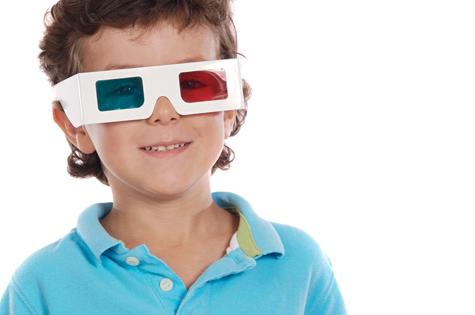With so many summer blockbusters on at the movies, Australia's optometrists have cautioned against 3D movie viewing for young children and adults with impaired vision.
All 3D glasses work by filtering images so that the left eye sees one image, and the right eye sees a slightly different image. It's then up to the brain to fuse them together to perceive a 3D image.
For this process to happen, the viewer's eyes must work well together. Where their vision is underdeveloped or damaged, these 3D glasses may cause fatigue or irritation.
"Children and people with sensitive eyes or certain eye conditions may find their vision blurry and therefore a little distracting,” says Optometry Australia’s senior resident optometrist, Luke Arundel.
"For young children the glasses require the brain to work hard to process the images. During a long movie, this can create tiredness and discomfort. Adults that are required to wear 3D glasses on top of their prescription glasses may also find the extra layer a little uncomfortable, but the glasses themselves won't damage the eyes or impair your vision".
"While we understand the pressure on parents to allow their children to watch movies that are in 3D, we recommend that parents avoid allowing children under the age of six
access to 3D content, and access for those up to the age of 13 should be no more than moderate.”
Mr Arundel said that viewing 3D movies or television programs shouldn't be treated any differently to 2D versions.
"When watching any movie or television program it is important to sit at a comfortable distance from the screen so that any neck or eye strain is minimised," he said.
"Anyone who experiences vision conditions such as blur, spots, tiredness or headaches while watching a movie or playing computer games in 3D or 2D should have their eyes examined by an eye care professional.”
He sad that optometrists are able to measure the amount of 3D vision you have, also known as stereopsis, which in some circumstances stereopsis can be improved with vision correction or vision therapy.
Optometry Australia further urges parents to be aware of the impact of screen time on their children's eyes such as through watching TV, playing on smartphones, tablets and computers.
"Our research shows that our children's eyesight is on the decline not just because they
are using computers and tablets but because they spend more time indoors than ever before. This means they are not exercising their eyes effectively which is what naturally occurs when outdoors and this has been implicated in the rise in short-sightedness", Mr Arundel said.
Here are the optometrists' top tips for caring for your children's eyes.
- Limit children's 3D viewing to short periods.
- Before using 3D glasses read the warning labels.
- Do not use 3D glasses as an alternative to sunglasses.
- Ensure children play outdoors for a few hours each day.
- Make sure your child takes regular breaks when using a computer, a tablet or smartphone of at least 5-10 minutes every hour.
- Ensure that the room your child is using the device in is comfortably lit, so they don't have to strain their eyes.



















__small.png)










